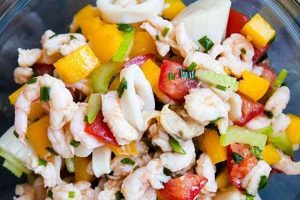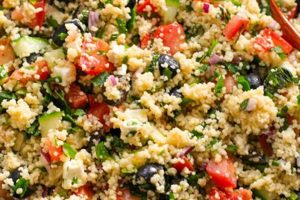Refreshing, vibrant salads complement grilled meats and the casual atmosphere of outdoor cooking during the warmer months. These dishes typically incorporate seasonal produce like ripe tomatoes, cucumbers, sweet corn, and berries. Examples include corn and avocado salad with a lime vinaigrette, grilled peach and prosciutto salad with arugula, and watermelon and feta salad with mint and a balsamic glaze.
Light, flavorful salads offer a counterpoint to rich barbecue fare, contributing balance and textural variety to the meal. They can be prepared in advance, freeing up the grill master to focus on the main course. Historically, salads have evolved alongside culinary traditions, adapting to available ingredients and cultural preferences. The abundance of fresh produce in summer naturally lends itself to a wide array of salad combinations perfect for outdoor gatherings.
This article will further explore specific salad recipes suitable for barbecues, covering ingredient selection, preparation techniques, and suggested pairings with popular grilled dishes. Additional information will be provided on variations and adaptations to cater to different dietary needs and preferences.
Tips for Creating Exceptional Barbecue Salads
The following tips offer guidance for crafting salads that enhance any barbecue gathering.
Tip 1: Embrace Seasonal Produce: Selecting peak-season fruits and vegetables ensures optimal flavor and freshness. Farmers’ markets offer a wide variety of locally sourced ingredients.
Tip 2: Balance Flavors and Textures: Combine sweet, savory, acidic, and crunchy elements for a more complex and satisfying salad. Consider incorporating grilled or roasted vegetables for added depth.
Tip 3: Consider the Main Course: Pair salads with complementary flavors to the grilled meats. For example, a light vinaigrette balances richer meats, while a bolder dressing complements lighter proteins.
Tip 4: Prepare Components in Advance: Wash, chop, and store ingredients separately to streamline assembly just before serving. Dressings can also be made ahead of time.
Tip 5: Think Beyond Leafy Greens: Explore grains, beans, pasta, or even fruit as a base for unique and substantial salads.
Tip 6: Don’t Overdress: Add dressing gradually, tasting as you go, to avoid a soggy salad. A light coating is often sufficient.
Tip 7: Garnish Thoughtfully: Fresh herbs, toasted nuts, seeds, or crumbled cheese can elevate the presentation and flavor profile.
By following these suggestions, one can create flavorful, visually appealing salads that perfectly complement the barbecue experience.
These tips provide a foundation for successful barbecue salad preparation. The following section will offer specific recipe ideas to inspire culinary creativity.
1. Fresh, Seasonal Ingredients
Summer barbecue salads distinguish themselves through the incorporation of fresh, seasonal ingredients. Peak-season produce offers optimal flavor and nutritional value, enhancing both the taste and the aesthetic appeal of these dishes. Utilizing readily available ingredients also aligns with sustainable practices, minimizing transportation and storage requirements.
- Locally Sourced Produce
Farmers’ markets and local farms provide access to a wide array of just-picked fruits and vegetables. Examples include ripe tomatoes, sweet corn, cucumbers, zucchini, and berries. These ingredients, harvested at their peak ripeness, offer superior flavor compared to produce that has been transported long distances. Supporting local agriculture strengthens community ties and reduces environmental impact.
- Herbs and Aromatics
Fresh herbs, such as basil, mint, cilantro, and parsley, add vibrancy and depth to summer salads. These aromatic ingredients can be incorporated directly into the salad or infused into dressings and vinaigrettes. Their flavors complement the sweetness of summer produce and enhance the overall sensory experience.
- Seasonal Fruits
Stone fruits like peaches, nectarines, and plums, as well as melons such as watermelon and cantaloupe, bring a refreshing sweetness and juiciness to summer salads. These fruits pair well with savory ingredients like cheeses, nuts, and grilled vegetables, creating balanced and complex flavor profiles.
- Availability and Sustainability
Choosing seasonal produce minimizes the need for long-distance transportation and storage, reducing the carbon footprint associated with food production. This practice supports sustainable agriculture and encourages the consumption of ingredients at their freshest and most flavorful.
The emphasis on fresh, seasonal ingredients elevates summer barbecue salads beyond simple side dishes. These vibrant, flavorful salads become integral components of the meal, contributing both nutritional value and aesthetic appeal while reflecting a commitment to sustainability and local sourcing.
2. Balancing Flavors (Sweet, Savory, Acidic)
Flavor balance is paramount in successful summer barbecue salads. The interplay of sweet, savory, and acidic elements creates a dynamic taste experience that complements rich grilled dishes and refreshes the palate. Careful consideration of these flavor profiles elevates salads from simple accompaniments to integral parts of the meal.
- Sweetness
Sweetness in salads can derive from various sources, including fruits (berries, melons, stone fruit), roasted vegetables (sweet potatoes, corn), or sweet dressings (honey, maple syrup). This element provides a counterpoint to savory and acidic components, creating a balanced and nuanced flavor profile. For example, grilled peaches offer sweetness against peppery arugula and salty feta.
- Savory
Savory notes ground the sweetness and acidity, providing depth and complexity. Sources of savory flavors include cured meats (prosciutto, bacon), cheeses (feta, goat cheese, parmesan), nuts (pecans, walnuts), and grilled or roasted vegetables. A sprinkle of toasted nuts or crumbled cheese can enhance the savory aspect of a salad, balancing the sweetness of fruit or a vinaigrette.
- Acidity
Acidity provides brightness and a refreshing contrast to richness. Vinegars (balsamic, red wine, apple cider), citrus juices (lemon, lime), and acidic fruits (tomatoes, berries) contribute acidity. A well-balanced vinaigrette provides not only acidity but also emulsifies the dressing, coating the salad ingredients evenly.
- Synergy and Harmony
Achieving flavor balance involves skillful combination. A salad featuring sweet grilled corn, savory bacon, and a tangy lime vinaigrette exemplifies this synergy. The sweetness of the corn is tempered by the smoky bacon, while the lime vinaigrette provides a refreshing acidity that cuts through the richness. This interplay of flavors creates a harmonious and satisfying sensory experience.
Mastering the art of balancing flavors is essential for crafting memorable summer barbecue salads. The thoughtful combination of sweet, savory, and acidic elements results in dishes that are not only refreshing but also enhance the overall dining experience by complementing the flavors of the main course.
3. Textural Variety
Textural variety is a critical component of compelling summer barbecue salads. Beyond flavor, the interplay of textures elevates these dishes, creating a more engaging and satisfying culinary experience. A well-composed salad offers a dynamic contrast of textures, stimulating the palate and adding depth to each bite. This element is crucial in balancing the often-rich flavors of barbecued main courses.
- Crunchy Elements
Crunchy elements provide a satisfying contrast to softer ingredients. Raw vegetables such as cucumbers, carrots, bell peppers, and celery offer crispness. Nuts, seeds, and croutons contribute additional crunch. For example, toasted pepitas add a satisfying bite to a salad with grilled corn and black beans.
- Soft and Tender Components
Softer textures, often from leafy greens, cooked grains, or roasted vegetables, create a textural counterpoint to crunchier elements. Grilled zucchini or roasted sweet potatoes offer a tender texture that complements the crispness of raw greens or nuts. Delicate herbs like parsley and dill contribute a soft, feathery touch.
- Creamy Textures
Creamy ingredients add richness and bind the salad together. Avocados, cheeses (feta, goat cheese, mozzarella), and creamy dressings contribute this element. For instance, avocado adds a creamy texture to a salad with grilled chicken and crunchy romaine lettuce, creating a harmonious balance.
- Chewy Textures
Chewy textures offer another layer of complexity. Dried fruits, such as cranberries or apricots, and cooked grains, such as quinoa or farro, provide chewiness. These elements create textural interest and contribute to a more substantial salad, especially when combined with lighter ingredients.
The strategic combination of these varied textures elevates summer barbecue salads from simple sides to memorable culinary experiences. A well-balanced mix of crunchy, soft, creamy, and chewy elements creates a symphony of textures that complements the flavors of the grilled main course and provides a satisfying and dynamic sensory experience.
4. Make-Ahead Components
Efficiency and ease of preparation are highly valued in summer barbecue settings. Make-ahead components play a crucial role in streamlining the salad-making process, allowing hosts to focus on other aspects of the barbecue, such as grilling the main course and socializing with guests. Utilizing make-ahead components minimizes last-minute stress and ensures that fresh, flavorful salads are ready to be enjoyed without delay.
Several salad components lend themselves well to advance preparation. Dressings and vinaigrettes can be made days in advance and stored in airtight containers in the refrigerator. Washing and chopping vegetables, such as lettuce, tomatoes, cucumbers, and onions, can also be done ahead of time. Storing these prepped ingredients in separate containers prevents premature wilting or sogginess. Grains, such as quinoa or farro, can be cooked and chilled, ready to be incorporated into the salad when needed. Even components like grilled corn or roasted vegetables can be prepared a day or two in advance. For example, a grilled corn and black bean salad can be assembled just before serving by combining the pre-grilled corn, pre-cooked black beans, chopped red onion, and cilantro with a pre-made lime vinaigrette.
Strategic use of make-ahead components significantly reduces preparation time on the day of the barbecue. This allows for a more relaxed and enjoyable experience, ensuring that the focus remains on the gathering itself rather than last-minute kitchen tasks. Furthermore, the ability to prepare elements in advance contributes to better overall organization and reduces the likelihood of errors or omissions during the busy preparation period. This approach is particularly beneficial for larger gatherings where time management is critical.
5. Complementary to Grilled Dishes
Summer barbecue salad recipes are designed not merely as side dishes, but as integral components that enhance and complement the flavors of grilled meats. Careful consideration of flavor profiles and textures ensures that the salad balances, rather than competes with, the main course, creating a harmonious and satisfying dining experience.
- Balancing Richness and Acidity
Grilled meats often possess rich, smoky, and sometimes fatty flavors. Salads can provide a refreshing counterpoint through acidity. Vinaigrettes with lemon juice, vinegar, or other acidic components cut through the richness of the grilled dishes, cleansing the palate. For example, a bright citrus vinaigrette complements the smoky char of grilled salmon, while a tangy vinegar-based dressing balances the richness of barbecued ribs.
- Contrasting Textures
Grilled foods typically offer a charred, sometimes crispy exterior and a tender interior. Salads can introduce contrasting textures through crunchy vegetables, creamy cheeses, or chewy grains. A salad with crisp romaine lettuce, crunchy croutons, and creamy Parmesan cheese provides a textural counterpoint to the tender, smoky flavor of grilled chicken. Similarly, a quinoa salad with toasted nuts and dried cranberries offers a chewy and crunchy contrast to grilled steak.
- Highlighting Seasonal Flavors
Summer barbecue salads frequently feature fresh, seasonal produce, which complements the flavors of grilled dishes. Sweet corn, ripe tomatoes, and juicy watermelon, for example, enhance the overall summery theme of the meal. A grilled peach salad with prosciutto and balsamic glaze complements the sweetness of grilled pork, while a corn and avocado salad with a lime vinaigrette enhances the flavors of grilled fish.
- Lightness and Freshness
Heavy, rich salads can overwhelm the palate when paired with grilled meats. Summer barbecue salads often prioritize lightness and freshness, offering a refreshing contrast to the richness of the main course. Ingredients such as leafy greens, fresh herbs, and light vinaigrettes contribute to this lightness, ensuring the salad complements rather than overpowers the meal. A simple salad of mixed greens with a light vinaigrette provides a refreshing counterpoint to hearty grilled sausages.
The success of a summer barbecue salad lies in its ability to complement the flavors and textures of the grilled dishes. By carefully balancing richness and acidity, contrasting textures, highlighting seasonal flavors, and prioritizing lightness and freshness, these salads become integral components of the barbecue experience, enhancing the overall enjoyment of the meal.
Frequently Asked Questions
This section addresses common inquiries regarding the preparation and enjoyment of salads suited for summer barbecues.
Question 1: Can salads be prepared in advance for a barbecue?
Components such as dressings, chopped vegetables, and cooked grains can be prepared a day or two in advance and stored separately. Combine ingredients just before serving to maintain optimal freshness and prevent sogginess. Leafy greens should be washed and dried, then stored separately from other components to prevent premature wilting.
Question 2: What are ideal dressings for barbecue salads?
Light, flavorful vinaigrettes often complement grilled dishes well. Consider citrus-based dressings (lemon, lime), or those incorporating herbs like basil or mint. Avoid heavy, creamy dressings that might clash with the richness of barbecued meats. The intensity of the dressing should balance the flavors of the main course.
Question 3: How can one ensure a barbecue salad remains fresh in warm weather?
Keep salads chilled until serving. Utilize serving bowls nested in larger bowls filled with ice to maintain a cool temperature. Avoid adding dressing until just before serving to prevent the salad from becoming soggy. Serve salads in smaller batches and replenish as needed to maintain freshness.
Question 4: Beyond leafy greens, what other bases can be used for barbecue salads?
Grains like quinoa, farro, or orzo pasta offer substantial bases. Legumes such as black beans or chickpeas provide protein and fiber. Even fruit, like watermelon or grilled peaches, can serve as a base for a unique and refreshing salad.
Question 5: How can salads be adapted for guests with dietary restrictions?
Offer a variety of toppings and dressings so guests can customize their salads. Clearly label ingredients containing common allergens. Provide gluten-free options for croutons and dressings. Ensure vegetarian or vegan options are available, omitting cheese or meat-based ingredients as necessary.
Question 6: What are some strategies for making barbecue salads more visually appealing?
Consider the color palette of ingredients, aiming for a vibrant and varied presentation. Utilize different cutting techniques for vegetables to add visual interest. Garnish with fresh herbs, edible flowers, toasted nuts, or seeds. Arrange salads thoughtfully on platters, considering height and texture.
Advance preparation, balanced flavors, and attention to freshness elevate barbecue salads from simple sides to essential components of the meal. Adaptability and visual appeal further enhance the dining experience.
The following section offers a collection of specific summer barbecue salad recipes, putting these principles into practice.
Summer Barbecue Salad Recipes
Summer barbecue salad recipes offer a crucial balance to the richness of grilled fare. Careful consideration of seasonal ingredients, flavor profiles, and textural variety elevates these dishes beyond simple accompaniments. Advance preparation and adaptability to dietary needs ensure a seamless and enjoyable culinary experience. Freshness, vibrant colors, and thoughtful presentation enhance the aesthetic appeal, transforming salads into integral components of the barbecue feast.
Exploration of diverse flavor combinations and innovative ingredient pairings expands the possibilities of summer barbecue salad recipes. Continued emphasis on fresh, locally sourced produce reinforces the connection between culinary creativity and sustainable practices. The evolution of these recipes promises to further enrich outdoor dining experiences, celebrating the flavors of summer while promoting mindful consumption.






